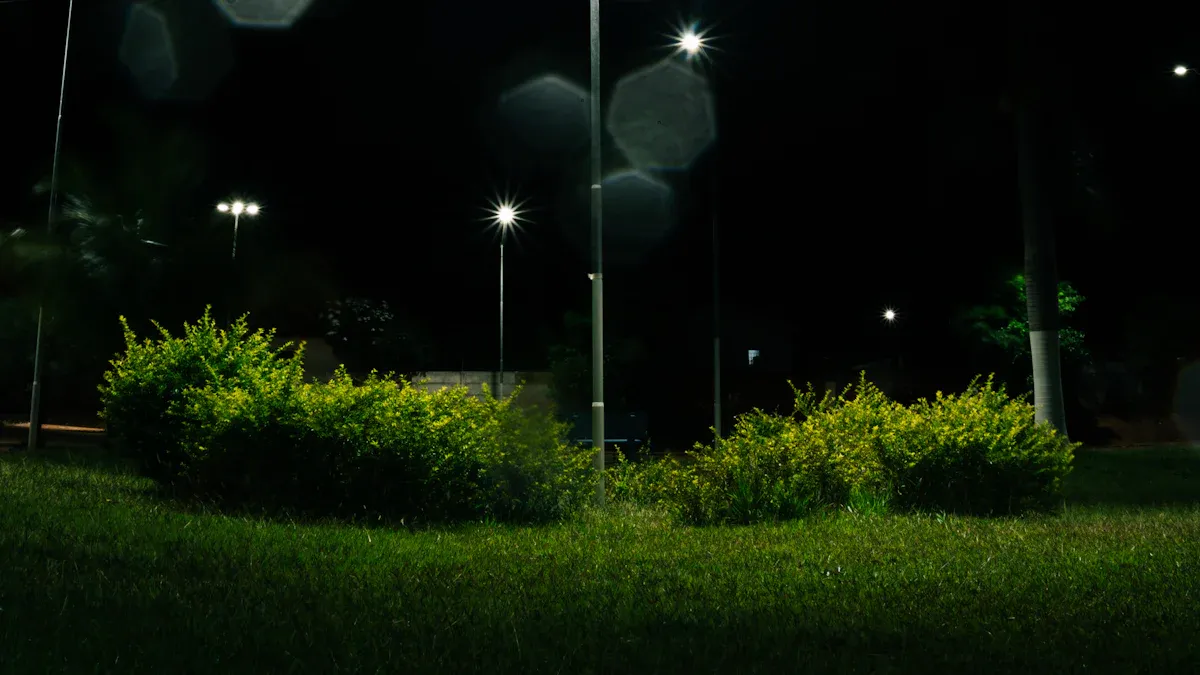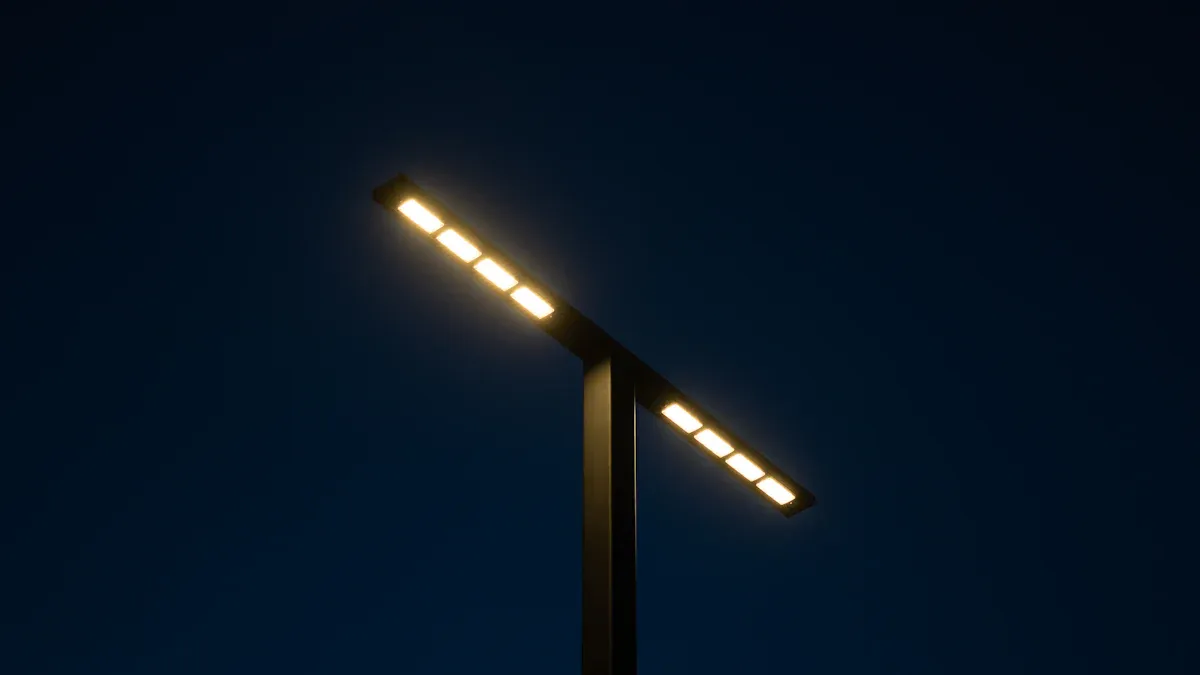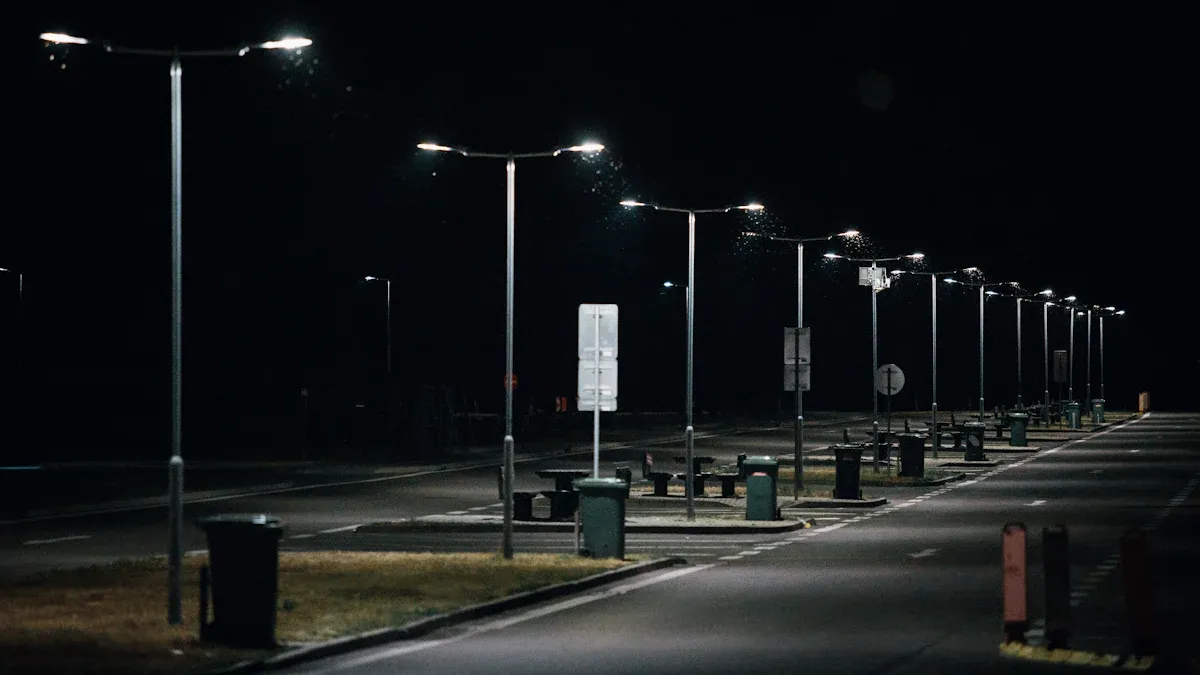Emerging Trends Shaping LED Street Lighting in 2025

You will notice big changes in LED Street Lighting in 2025. Cities pick smart systems that save energy and money. New Led Light technology helps towns use 50–70% less energy. It also helps lower carbon emissions. You will see more smart features, like sensors and IoT. These features make places safer and better for people. More people want these lights because cities are growing. Governments help and people care about the environment. Home, About Us, and Product pages talk about these good things. They show how lighting helps make cities better.
Key Takeaways
LED street lighting uses much less energy. It can cut energy use by 50-70%. This helps cities save money. It also lowers carbon emissions.
Smart integration lets people control lights from far away. It can change how bright the lights are. This makes cities safer and more efficient.
IoT connectivity gives real-time data. This helps cities use less energy. It also helps lower maintenance costs.
Using LED lights helps cities meet sustainability goals. It lowers greenhouse gas emissions a lot.
Investing in LED street lighting helps people feel better in their community. It makes streets safer. It also helps people spend more time outside.
LED Street Lighting Trends

Smart Integration
LED Street Lighting systems now do more than just light up roads. These smart systems use new technology to help cities work better and stay safe. Some features you might see are:
IoT-enabled smart controls let you change lights from far away.
LoRaWAN and NB-IoT protocols help dim lights and send alerts fast.
Wireless communication helps plan repairs before things break.
Adaptive lighting changes how bright lights are when cars or people pass.
Tip: Smart integration saves energy and money. It also helps keep your city safer by letting you control the lights better.
Smart LED Street Lighting can get brighter or dimmer if the weather changes or if the street gets busy. These systems send alerts if something is wrong, so you can fix it fast. You help your city save money and energy while making streets safer for everyone.
IoT Connectivity
IoT connectivity changes how you take care of street lighting. Sensors and real-time data help you know how much light each street needs. You can also check traffic and weather. This means you only use energy when you need it. IoT helps you find problems early, so you spend less on repairs and keep lights working longer. You help your city work better and save money at the same time.
Note: IoT-connected LED Street Lighting systems collect data. This data helps you make smart choices about energy and repairs.
Challenge | Description |
|---|---|
Data Privacy Concerns | Protecting personal data collected by street lights. |
Integration of Sensors and Actuators | Making sure all devices work together smoothly. |
Robust Device Communication | Keeping communication secure and reliable. |
Surveillance Risks | Preventing misuse of data that could affect civil liberties. |
High Initial Costs | Paying for new smart lighting systems. |
Ongoing Maintenance | Keeping systems updated and working over time. |
You should always think about privacy and safety when using IoT in street lighting. Listening to the community and having strong rules helps keep everyone’s data safe.
Energy Efficiency
LED Street Lighting uses much less energy than old lights. You can cut energy use by 50–70% just by switching to LEDs. Adding smart controls saves even more. For example, Amsterdam used 65% less energy with smart controls. Los Angeles saved 63% after changing over 215,000 streetlights to LED with smart features. Wolverhampton saved over 350,000 kilowatt-hours in one year and cut costs by more than £100,000.
Aspect | LED Street Lights | Traditional Lighting |
|---|---|---|
Maintenance Costs | Save about 90% over lifespan | Higher due to more repairs |
Energy Costs | Save about 30% on energy | Higher energy use |
Example Savings | NYC saves $4.5 million/year | N/A |
You spend less on repairs and energy bills with LED Street Lighting. This means you have more money for other city projects.
Sustainability
You help the planet when you pick LED Street Lighting. LEDs use 75% less energy than old lights. This means you lower greenhouse gas emissions and help your city reach its sustainability goals. Many cities see big drops in carbon pollution after switching to LEDs. For example, one city saved 114 gigawatt hours each year and cut 67,000 metric tons of carbon emissions. Another project cut carbon by over 1,800 metric tons, which is like taking 400 cars off the road.
Did you know? LED Street Lighting is often the biggest carbon-reducing project a city can do.
LEDs use much less energy than old bulbs.
Lower energy use means fewer greenhouse gases.
Big energy savings help cities become more sustainable.
Metric | Description |
|---|---|
Energy Efficiency | LEDs give more light for less energy, saving money. |
Longevity | LEDs last over 50,000 hours, so you replace them less often. |
Environmental Concerns | Making LEDs uses rare materials, so proper disposal is important. |
New Materials
New materials make LED Street Lighting even better. Scientists made a hybrid copper-iodide material that makes LEDs stronger and brighter. This material turns almost all energy into blue light, which is very bright and clear. Blue LEDs made from this material last longer and work better than many older types. The special way these LEDs are made helps them last over 200 hours before losing half their brightness.
You also get lights that last longer. LED streetlights can last 50,000 to 100,000 hours. You do not need to replace them as often, which saves time and money. High-quality parts help these lights stand up to bad weather and heavy use. With better materials and smart sensors, you can spot problems early and fix them before they cause trouble.
Lighting Type | Lifespan (hours) | Maintenance Frequency | Cost Implications |
|---|---|---|---|
Incandescent | 1,000 - 2,000 | High | Higher due to frequent replacements |
LED | 50,000 - 100,000 | Low | Lower due to fewer replacements |
You help your city shine brighter, save money, and protect the environment by choosing the latest LED Street Lighting technology.
Impact in 2025
Urban Development
Cities will look different in 2025 because of LED Street Lighting. These new lights use IoT and 5G to change brightness quickly. This makes streets safer and helps cities run better. AI and big data help use only the light that is needed. This saves energy and money for everyone. Some cities use spectral optimization for healthier light. This also helps cut down on light pollution. Augmented reality can make parks and public places more fun. New laws about light pollution mean cities must use better lighting.
Trend Description | Projected Impact on Urban Development |
|---|---|
Integration of IoT and 5G technology | Makes cities safer and more efficient by adjusting lights in real time. |
AI and big data analytics | Saves energy by using only the light needed. |
Spectral optimization | Reduces light pollution and supports healthy ecosystems. |
Augmented reality technology | Creates fun and engaging public spaces. |
Stricter laws on light pollution | Improves health for people and nature. |
Streetlights now have sensors that watch traffic, air, and weather. Solar LED street lights work even without the main power grid. This helps places that do not have much electricity. Good lighting makes it safer to walk at night. Fewer accidents happen when streets are bright. Using renewable energy with LED Street Lighting saves more energy. It also helps protect the environment.
Environmental Benefits
LED Street Lighting is good for the planet. These lights use less energy, so fewer greenhouse gases go into the air. LED lights do not have mercury, so they make less dangerous waste. You do not need to change LED lights as often. This means less trash goes to landfills. If all streetlights in the U.S. used LEDs, the energy saved would power 1.5 million homes for a year.
LED streetlights shine light down, so less light goes into the sky.
This helps drivers and walkers see better at night.
Cities say public spaces are safer and more lively with these lights.
LED Street Lighting can use 6%–75% less energy than old lights.
LED streetlights make 16% less greenhouse gas than high-pressure sodium lights.
Switching to LED Street Lighting helps cities be greener and lowers carbon emissions.
Community Well-being
People feel safer when streets are bright at night. LED Street Lighting helps you see better and keeps crime down. More people go outside when they feel safe. This helps neighbors get to know each other. Studies show that better lighting lowers crime, almost as much as more police. In Newark, NJ, violent crime went down after new LED streetlights were put in. People say they feel safer and spend more time outside.
LED streetlights give bright, even light so you can see danger.
Bright streets make it hard for criminals to hide.
Good lighting lowers car and walking accidents at night.
More people outside means less chance for crime.
"These new LED lights put light where it is needed most, making streets much safer."
When you support LED Street Lighting, you help your community stay safe, active, and close.
Examples & Projections

Leading Cities
Some cities are leading with LED street lighting. These cities show what can happen with new technology. Los Angeles and Boston changed many of their streetlights. Chennai in India is also known for smart city projects.
City | Project Description | Energy Savings | Cost Savings | Key Outcomes |
|---|---|---|---|---|
Los Angeles | Largest LED streetlight replacement program, replacing over 140,000 streetlights. | 63% decrease in energy consumption | $9 million annually | Improved nighttime visibility, reduced carbon emissions, enhanced safety. |
Chennai | 70% of streetlights converted to LED as part of the Smart City Initiative. | INR 68 crores savings | Rs 2.94 crores cost | Centralized monitoring, low maintenance, optimized energy consumption. |
Tip: These cities do more than save money. They make streets safer, lower pollution, and improve life for people.
Here are some other cities doing well:
City | Achievement | Energy Savings |
|---|---|---|
Los Angeles | Updated more than 100,000 streetlight fixtures with LEDs | Over 60% |
Boston | Upgraded many electric streetlights with LEDs to lower carbon footprint | N/A |
Adoption Rates
You might ask how quickly cities switch to LED street lighting. The numbers show that more cities use LEDs every year. In 2023, LED lighting made up almost 80% of all street lighting money. Outdoor lighting uses LEDs more than indoor lighting. Outdoor lighting has a 51.4% adoption rate. Indoor lighting is at 29.8%. By 2030, experts think LEDs will be in 87% of all lighting.
In 2023, LED lighting made up 79.7% of global street lighting revenue.
Outdoor lighting has a 51.4% adoption rate for LEDs.
Indoor lighting adoption is at 29.8%.
By 2030, LED penetration is expected to reach 87% across all lighting sectors.
India’s LED street lighting market is growing fast. Government programs help cities put in more LED lights. The Asia-Pacific region is ahead in LED street lighting. Big cities and smart city projects often use LEDs first.
🌍 When you pick LED street lighting, your city saves energy and money. More cities are making this choice each year.
Adoption Challenges
Infrastructure
Upgrading to LED street lighting is not always easy. Small towns may find the costs too high. Old systems can be hard to change. Sometimes, parts do not work well together. You might have trouble with heat or dimming. Skilled workers are needed to fix and keep things running. Small towns may not have enough people for this.
Challenge Type | Description |
|---|---|
Regulatory Barriers | Utilities may not offer LED street lighting rates, limiting availability to municipalities. |
High Upfront Costs | Initial financial investment is significant, especially for smaller municipalities with tight budgets. |
Complex Procurement | Navigating environmental compliance and utility coordination can be resource-intensive and slow. |
Solar smart street lights can make things easier. Lightweight poles help with quick setup. Compact designs fit on small roads. Battery storage keeps lights on longer. Adaptive controls change brightness for traffic. Some cities use new lights that look old to keep people happy. People may worry about how lights look or about privacy. Talking openly helps everyone trust the project.
Security
Smart LED street lighting can have security problems. Hackers may attack open APIs or shared Wi-Fi passwords. This happened with Philips Hue and LIFX. Attacks can turn off lights or steal data. More connected lights mean more risk for cities. Data leaks and ransomware can happen.
🔒 Use strong passwords and update software often. Teach people about security. Encryption and trusted solutions keep city lights safe.
Cities now use better rules and updates to stop threats. Encryption protects data from hackers. You help keep your city’s lights safe.
Policy
Rules and laws can slow down LED street lighting projects. Many groups must agree, so things take longer. Small budgets and who owns the lights can stop upgrades. Sometimes, utilities own the lights, so cities do not want to change them. City departments may not work together, making it hard to add new features.
Barrier Type | Description |
|---|---|
Complex regulation | Involves several entities, complicating the adoption process. |
Financial constraints | Municipalities require a minimum of 20,000 street lighting points to make a profitable case. |
Political conflicts | Prevent collaboration among municipalities for tenders, hindering economies of scale. |
Ownership model | Local utilities often own streetlights, leading to a lack of cost incentive for smart lighting. |
Departmental silos | Makes it difficult for city governments to implement smart street lighting with extra features. |
Grants and tax credits from the government can help. These programs make projects cheaper and easier to start. Look for these options to help your city succeed.
LED street lighting is changing how cities look and work. Smart systems and IoT help make streets safer. They also help cities use energy better. The smart street lighting market could be worth $9.9 billion by 2025. These new lights can save up to 80% of energy.
City planners and policymakers should:
Pick ways to save money as more outdoor LEDs are used.
Put money into smart lighting to manage energy better.
Use global rules to make sure lights are good and reliable.
Try IoT-integrated lighting for easy control.
Pick solar-LED hybrids for places with weak power.
Follow rules to join big lighting projects.
Be ready for new ideas and changes. Your choices help make cities brighter, safer, and better for the planet.
FAQ
What makes LED street lighting better than old streetlights?
You get brighter light and use less energy with LEDs. These lights last longer and need fewer repairs. You help your city save money and protect the environment.
How do smart LED streetlights help your city?
Smart LED streetlights let you control brightness and timing. You can use sensors to adjust lights for traffic or weather. This keeps streets safer and saves energy.
Are LED streetlights safe for people and animals?
LED streetlights use less harmful materials. You can pick lights with the right color to reduce glare and protect wildlife. Cities use shields to keep light from shining into homes or the sky.
Can you install LED streetlights in small towns?
Yes! Many small towns use LED streetlights. You can start with a few lights and add more over time. Grants and government programs help pay for upgrades.
See Also
Choosing Ideal LED Street Lights for Your Community in 2025
The Progression of LED Street Lights: Innovations and Trends
Understanding the Advantages and Technology of LED Street Lights
Comprehensive Overview of LED Street Light Technologies
LED Street Lights: Benefits of Energy Efficiency and Longevity

